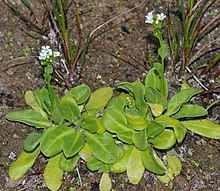
The Primulaceae, commonly known as the primrose family, are a family of herbaceous and woody flowering plants including some favourite garden plants and wildflowers. Most are perennial though some species, such as scarlet pimpernel, are annuals.

Rumex crispus, the curly dock, curled dock or yellow dock, is a perennial flowering plant in the family Polygonaceae, native to Europe and Western Asia.
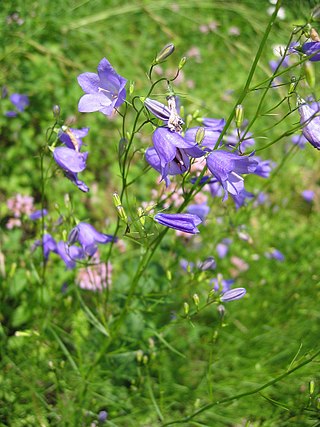
Campanula rotundifolia, the harebell, Scottish bluebell, or bluebell of Scotland, is a species of flowering plant in the bellflower family Campanulaceae. This herbaceous perennial is found throughout the temperate regions of the northern hemisphere. In Scotland, it is often known simply as bluebell. It is the floral emblem of Sweden where it is known as small bluebell. It produces its violet-blue, bell-shaped flowers in late summer and autumn.
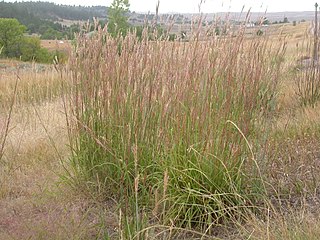
Andropogon gerardi, commonly known as big bluestem, is a species of tall grass native to much of the Great Plains and grassland regions of central and eastern North America. It is also known as tall bluestem, bluejoint, and turkeyfoot.

Samolus is a widely distributed genus of about a dozen species of water-loving herbs. According to the APG III classification, this genus belongs to the family Primulaceae in the order Ericales. It was considered as closely related to a clade comprising the Theophrastaceae, and was treated as part of that family or in its own monogeneric family, the Samolaceae. The APG III system does not recognize these families and instead includes all genera formerly belonging to Theophrastaceae in the family Primulaceae.

Cypripedium acaule is a species of flowering plant in the orchid family Orchidaceae native to eastern North America. It is currently the provincial flower of Prince Edward Island, Canada, and the state wildflower of New Hampshire, United States.

Theophrastoideae is a small subfamily of flowering plants in the family Primulaceae. It was formerly recognized as a separate family Theophrastaceae. As previously circumscribed, the family consisted of eight genera and 95 species of trees or shrubs, native to tropical regions of the Americas.

Allium cernuum, known as nodding onion or lady's leek, is a perennial plant in the genus Allium. It grows in open areas in North America.

Primula pauciflora, the pretty shooting star, few-flowered shooting star, dark throat shooting star or prairie shooting star, is a species of flowering plant in the primula family Primulaceae. It is a widespread and very variable species, native to western North America, from Subarctic America to Mexico, often in xeric and desert habitats. It is found in the Great Basin Deserts and Mojave Desert. Its synonyms include Dodecatheon pauciflorum and Dodecatheon pulchellum.

Lobelia siphilitica, the great blue lobelia, great lobelia, or blue cardinal flower, is a plant species within the family Campanulaceae. It is an herbaceous perennial dicot native to eastern and central Canada and United States. There are two recognized varieties of Lobelia siphilitica, var. siphilitica and var. ludoviciana. Blooming from August to October, it is short-lived, lasting only for a few years.

Ornithostaphylos is a monotypic plant genus which contains the single species Ornithostaphylos oppositifolia, commonly known as the Baja California birdbush or Baja California manzanita. A large, evergreen shrub in the heather family, this species is near-endemic to northwestern Baja California, with a small population just north of the border in San Ysidro, California. It produces a much-branched inflorescence of white, urn-shaped flowers, and has leathery leaves that appear opposite or in whorls. These characteristics separate it from its close relatives in the region, which include manzanitas (Arctostaphylos), summer holly (Comarostaphylis) and mission manzanita (Xylococcus).
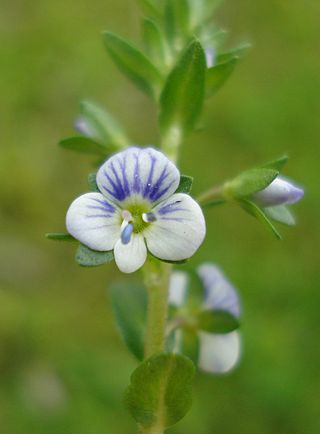
Veronica serpyllifolia, the thyme-leaved speedwell or thymeleaf speedwell, is a perennial flowering plant in the plantain family. It is native to Europe, but can be found elsewhere on most continents as an introduced species.

Lysimachia vulgaris, the yellow loosestrife or garden loosestrife, is a species of herbaceous perennial flowering plant in the family Primulaceae. It was transferred to Myrsinoideae based on results of molecular phylogenetic research before being merged into the Primulaceae.

Leucopogon parviflorus, commonly known as coast beard-heath or native currant, is a shrub or small tree in the family Ericaceae. It is native to all Australian states and territories excluding the Northern Territory and the ACT and also grows in New Zealand. The species can grow to between 1 and 5 metres in height and has leaves that are 11 to 29 mm long and 2.4 to 7.5 mm in width, often with curved tips. The white flowers are around 15 mm long and are produced in spikes of 7 to 13. These occur throughout the year.
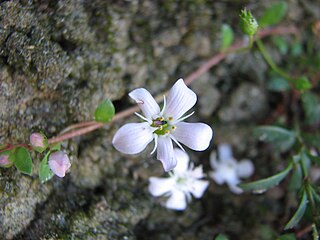
Samolus repens is a species of water pimpernel native to Australia, New Zealand and near-by Pacific islands, and South America, where it is common in temperate and subtropic coastlines. Common names include creeping brookweed and creeping bushweed. Samolus repens has small white or occasionally pink flowers with a flowering period from September through to March or April.

Lysimachia foemina is commonly known as blue pimpernel or poor man's weatherglass, and was formerly called Anagallis foemina. It is a low-growing annual herbaceous plant in the genus Lysimachia of the family Primulaceae. In a comparison of DNA sequences, L. foemina was shown to be most closely related to L. monelli. It had been thought by many to be closest to L. arvensis, and some authors had even included L. foemina as a subspecies of L. arvensis, as Anagallis arvensis subsp foemina. These three species were among several transferred from Anagallis to Lysimachia in a 2009 paper.

Primula austrofrigida, syn. Dodecatheon austrofrigidum, is a species of flowering plant in the primrose family known by the common names frigid shooting star and tundra shooting star. It is native to Washington and Oregon in the United States, where it grows in the coastal mountain ranges, including those on the Olympic Peninsula.

Lysimachia clethroides, the gooseneck loosestrife, is a species of flowering plant, traditionally classified in the family Primulaceae. It was transferred to the family Myrsinaceae based on a molecular phylogenetic study, but this family was later merged into the Primulaceae.

Samolus ebracteatus, the limewater brookweed, is a plant species known to Mexico, Central America, the West Indies, and to the United States. It is found in wetlands, including seashore salt marshes, and near springs and intermittent rivers in desert areas.

Tradescantia longipes, commonly known as the wild crocus, is a perennial herbaceous plant in the dayflower family. It is found only in the Ozark Mountains of southern Missouri and northern Arkansas in the Midwest United States. A spring blooming species, its flowers can be observed from April to May, typically in its preferred habitat of wooded slopes on rocky hillsides. While most other members of the genus in North America have stems reaching at least a few inches above the soil, the flowering shoots of Tradescantia longipes are borne essentially at ground level. This character is shared with some individuals of Tradescantia hirsuticaulis and Tradescantia virginiana, two closely related species, although both typically have obvious stems. Regardless, Tradescantia longipes can be distinguished from the former with its longer pedicels and bracts without fine hairs, and from the latter by the presence of at least some glandular hairs on the sepals. Furthermore, Tradescantia longipes is a tetraploid, meaning it has four sets of chromosomes, while Tradescantia hirsuticaulis is diploid with only two sets. Tradescantia virginiana occurs in both diploid and tetraploid forms, although it is consistently tetraploid where its range overlaps with Trandescantia longipes.
